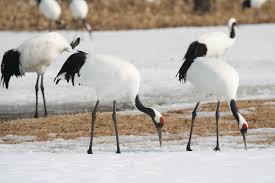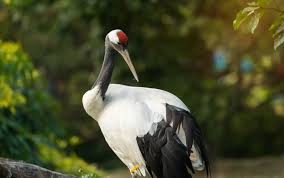
Red Crowned Crane/Manchurian Crane/Japanese Crane!

The Red-Crowned Crane ( Grus japonensis is a majestic bird that has captured the imagination of humans for centuries. In East Asia, it is considered a symbol of good luck and longevity, and it is even depicted in traditional art and folklore. But what makes this bird so special? In this article, we will explore the biology, behavior, and cultural significance of the red-crowned crane.
The Red-crowned Crane, or Grus japonensis, is a large bird in the crane family. It is native to East Asia and is found in China, Japan, Russia, and Mongolia. The Red-Crowned Crane is listed as an endangered species on the IUCN Red List due to its declining population caused by a variety of factors including habitat loss, pollution, and hunting. There are around 2,500-3,000 red-crowned cranes in the wild, with most living in China and Japan. The Red-Crowned Crane is a large bird, standing up to 5 feet tall and with a wingspan of up to 8 feet. It is instantly recognizable by its distinctive red crown, white body, and black wingtips. It also has long, thin legs, a long, curved neck, and a long, pointed beak. When it spreads its wings, it reveals intricate patterns of black, white, and brown feathers. Its graceful movements have earned it the nickname ‘dancing crane.’
The Red-Crowned Crane is known for its unique behavior, including its dancing. It is often seen dancing in pairs, with one bird bowing and calling to the other. The dance can last for several minutes and involves a variety of movements, including jumping, wing-flapping, and head-bobbing. The dance is thought to be a form of communication and courtship, and is truly a sight to behold!
We should care about these birds because they play a vital role in our ecosystem! They obviously disperse seeds, aerating soils(breaking soil to be more porous) and controlling insect populations They are identified as the “keystone species” because they have a disproportionate impact on the environment. When the Red-Crowned bird is around they contribute to the health of the environment by keeping the balance of plants and animals They are a food source to animals like fox, raccoons and birds of prey.
Now onto the fun facts, did you know the Red-Crowned crane is the second-largest species of the Crane family as it can grow up to to 5 feet? The most striking feature its know for is it elaborate courtship dance which includes trumpeting, jumping, bowing and dancing with their wings! They are one of the most faithful species on earth as they mate for life. How about that!? And both parents take turns incubating their eggs and raising the young.
Did you know their one of the wold bird species in the world , with fossil records dating to a million years!
The Red-Crowned Crane’s diet consists mostly of plants, small fish, crustaceans, insects, snails, frogs, and small mammals. They are also known to eat rice, grain, and seeds. In the winter, when food is scarce, they have been known to eat bark and pine needles. They forage by wading through shallow water or on land, using their long bills to probe for food. They often follow plows to eat earthworms and other invertebrates turned up by the plow. In China, it’s associated with happiness, wisdom, and loyalty. In Korea, the crane is seen as a messenger from the gods and a symbol of peace. It’s fascinating to see how this one bird can have such different meanings in different cultures.
Now that you know more about the iconic red-crowned crane we hope you think of protecting it while remembering the impressive lifespan and Its courtship dance and foraging behavior make it a truly fascinating bird to study and it plays an important role in the ecosystem.
